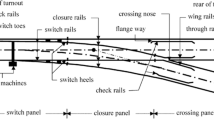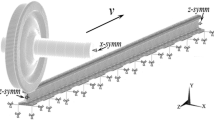Abstract
A new approach for solving three-dimensional elasto-plastic wheel-rail normal contact problems is presented, which is used to obtain the normal contact pressure distribution in the wheel-rail contact patch and its interior. First, the potential contact region dispersed by rectangular blocks is given. Then, the normal contact pressure in each block is iterated using the conjugate gradient algorithm, and the contact patch and normal contact pressure distribution under elastic conditions are obtained. After that, based on the proposed normal contact pressure correction equation and grid size correction equation, the size and normal contact pressure of each block are corrected, and so the normal contact pressure considering plastic deformation is obtained. Finally, the wheel-rail normal contact pressure under different lateral displacements and normal forces is calculated using the finite element method, and the accuracy of the proposed method is verified. Results show that the computational efficiency of the proposed approach is much higher than that of the conventional finite element method, which can provide new inspiration for railway dynamics computation.

摘要
提出了一种求解三维弹塑性轮轨法向接触问题的新方法, 用于求解弹塑性轮轨接触下的接触斑和法向接触压力分布. 首先, 该 方法通过矩形网格离散可能的接触区域; 然后, 采用共轭梯度法对每个矩形网格中的法向接触压力进行迭代求解, 获取弹性情况下的 接触斑和法向接触压力分布; 进而, 通过提出的弹塑性修正方法, 对每个矩形网格的尺寸和法向接触压力进行修正, 得到弹塑性情况下 的轮轨接触斑和法向接触压力分布; 最后, 基于不同横移量和法向合力下的有限元计算结果, 对该方法进行验证. 结果表明, 该方法具 有较高的计算精度和计算效率, 可为轮轨接触问题的研究提供参考.
Similar content being viewed by others
References
J. Z. Zhao, X. Xu, L. Ding, Q. H. Kan, and G. Z. Kang, Finite element analysis of rolling strengthening process for wheel tread of high-speed trains (in Chinese), J. Southwest Jiaotong Univ. 55, 1337 (2020).
M. C. Dubourg, and V. Lamacq, A predictive rolling contact fatigue crack growth model: Onset of branching, direction, and growth—role of dry and lubricated conditions on crack patterns, J. Tribol. 124, 680 (2002).
Y. Yang, X. Guo, L. Ling, K. Wang, and W. Zhai, Effect of gauge corner lubrication on wheel/rail non-Hertzian contact and rail surface damage on the curves, Acta Mech. Sin. 38, 521522 (2022).
X. F. Zhou, J. N. Wang, L. Jing, and K. Y. Wang, Elastic-plastic theory analysis of the mechanical behavior of three-dimensional wheel-rail normal contact (in Chinese), Chin. J. Solid Mech. 43, 434 (2022).
M. B. Marshall, R. Lewis, R. S. Dwyer-Joyce, U. Olofsson, and S. Björklund, Experimental characterization of wheel-rail contact patch evolution, J. Tribol. 128, 493 (2006).
Z. Wen, X. Jin, and Y. Jiang, Elastic-plastic finite element analysis of nonsteady state partial slip wheel-rail rolling contact, J. Tribol. 127, 713 (2005).
X. Deng, Y. Q. Ni, and X. Liu, Numerical analysis of transient wheel-rail rolling/slipping contact behaviors, J. Tribol. 144, 101503 (2022).
R. Lundén, and B. Paulsson, 1-Introduction to wheel-rail interface research, in: Wheel-Rail Interface Handbook, edited by R. Lewis and U. Olofsson (Woodhead Publishing, Sawston, Cambridge, 2009).
F. Yang, Z. Wei, X. Sun, C. Shen, and A. Núñez, Wheel-rail rolling contact behavior induced by both rail surface irregularity and sleeper hanging defects on a high-speed railway line, Eng. Fail. Anal. 128, 105604 (2021).
H. Zhang, X. R. Ran, J. Q. Cai, F. T. Lin, and X. G. Wang, Influence of wheel-rail contact geometry nonlinear parameter on vehicle dynamics performance (in Chinese), J. Railw. Sci. Eng. 19, 1743 (2022).
K. L. Johnson, Contact Mechanics (Cambridge University Press, Cambridge, 1985).
F. W. Carter, On the action of a locomotive driving wheel, Proc. R. Soc. Lond. A 112, 151 (1926).
K. L. Johnson, The effect of a tangential contact force upon the rolling motion of an elastic sphere on a plane, J. Appl. Mech. 25, 339 (1958).
P. J. Vermeulen, and K. L. Johnson, Contact of nonspherical elastic bodies transmitting tangential forces, J. Appl. Mech. 31, 338 (1964).
Z. Y. Shen, J. K. Hedrick, and J. A. Elkins Manager of, A comparison of alternative creep force models for rail vehicle dynamic analysis, Veh. Syst. Dyn. 12, 79 (1983).
J. J. Kalker, On the Rolling Contact of Two Elastic Bodies in the Presence of Dry Friction, Dissertation for Doctoral Degree (Delft University, Delft, 1967).
J. J. Kalker, A fast algorithm for the simplified theory of rolling contact, Veh. Syst. Dynam. 11, 1 (1982).
J. J. Kalker, Three-Dimensional Elastic Bodies in Rolling Contact (Kluwer Academic Press, Netherlands, 1990).
L. W. Huang, Mechanics Analysis and Fatigue Life Prediction Method for Wheel/Rail Rolling Contact (in Chinese), Dissertation for Doctoral Degree (East China University of Science and Technology, Shanghai, 2018).
J. Piotrowski, and W. Kik, A simplified model of wheel/rail contact mechanics for non-Hertzian problems and its application in rail vehicle dynamic simulations, Veh. Syst. Dyn. 46, 27 (2008).
B. Liu, S. Bruni, and E. Vollebregt, A non-Hertzian method for solving wheel-rail normal contact problem taking into account the effect of yaw, Veh. Syst. Dyn. 54, 1226 (2016).
J. B. Ayasse, and H. Chollet, Determination of the wheel rail contact patch in semi-Hertzian conditions, Veh. Syst. Dyn. 43, 161 (2005).
A. Qazi, H. Yin, M. Sebès, H. Chollet, and C. Pozzolini, A semi-analytical numerical method for modelling the normal wheel-rail contact, Veh. Syst. Dyn. 60, 1322 (2022).
H. Magalhaes, F. Marques, P. Antunes, P. Flores, J. Pombo, J. Ambrósio, A. Qazi, M. Sebes, H. Yin, and Y. Bezin, Wheel-rail contact models in the presence of switches and crossings, Veh. Syst. Dyn. 61, 838 (2023).
E. A. H. Vollebregt, Detailed wheel/rail geometry processing using the planar contact approach, Veh. Syst. Dyn. 60, 1253 (2022).
S. Z. Meymand, A. Keylin, and M. Ahmadian, A survey of wheel-rail contact models for rail vehicles, Veh. Syst. Dyn. 54, 386 (2016).
J. Zhao, Q. Kan, P. Fu, G. Kang, and P. Wang, An elasto-plastic contact solving method for two spheres, Acta Mech. Solid Sin. 33, 612 (2020).
J. Zhao, P. Fu, X. Zhang, L. Zhou, P. Wang, and Q. Kan, An effective method for calculating elasto-plastic contact pressure and contact patch size under elliptical, circular and line contact conditions, Appl. Math. Model. 95, 541 (2021).
J. Zhao, H. Miao, Q. Kan, P. Fu, L. Ding, G. Kang, and P. Wang, Numerical investigation on the rolling contact wear and fatigue of laser dispersed quenched U71Mn rail, Int. J. Fatigue 143, 106010 (2021).
R. Masoudi Nejad, Z. Liu, W. Ma, and F. Berto, Reliability analysis of fatigue crack growth for rail steel under variable amplitude service loading conditions and wear, Int. J. Fatigue 152, 106450 (2021).
W. Yan, and F. D. Fischer, Applicability of the Hertz contact theory to rail-wheel contact problems, Arch. Appl. Mech. (Ingenieur Archiv) 70, 255 (2000).
Z. Wen, L. Wu, W. Li, X. Jin, and M. Zhu, Three-dimensional elastic-plastic stress analysis of wheel-rail rolling contact, Wear 271, 426 (2011).
C. Hardy, C. N. Baronet, and G. V. Tordion, The elasto-plastic indentation of a half-space by a rigid sphere, Int. J. Numer. Meth. Eng. 3, 451 (1971).
C. Thornton, and Z. Ning, A theoretical model for the stick/bounce behaviour of adhesive, elastic-plastic spheres, Powder Tech. 99, 154 (1998).
C. Thornton, S. J. Cummins, and P. W. Cleary, On elastic-plastic normal contact force models, with and without adhesion, Powder Tech. 315, 339 (2017).
C. Thornton, Coefficient of restitution for collinear collisions of elastic-perfectly plastic spheres, J. Appl. Mech. 64, 383 (1997).
M. R. W. Brake, An analytical elastic plastic contact model with strain hardening and frictional effects for normal and oblique impacts, Int. J. Solids Struct. 62, 104 (2015).
M. Sebès, H. Chollet, J. B. Ayasse, and L. Chevalier, A multi-Hertzian contact model considering plasticity, Wear 314, 118 (2014).
M. Sebès, L. Chevalier, J. B. Ayasse, and H. Chollet, A fast-simplified wheel-rail contact model consistent with perfect plastic materials, Veh. Syst. Dyn. 50, 1453 (2012).
H. Zhu, Y. Zhao, Z. He, R. Zhang, and S. Ma, An elastic-plastic contact model for line contact structures, Sci. China-Phys. Mech. Astron. 61, 054611 (2018).
I. A. Polonsky, and L. M. Keer, A numerical method for solving rough contact problems based on the multi-level multi-summation and conjugate gradient techniques, Wear 231, 206 (1999).
X. Zhang, Q. J. Wang, and T. He, Transient and steady-state viscoelastic contact responses of layer-substrate systems with interfacial imperfections, J. Mech. Phys. Solids 145, 104170 (2020).
S. Liu, D. X. Chen, Z. L. Xu, and L. K. Zheng, A multigrid preconditioned conjugate gradient method for isogeometric analysis (in Chinese), Appl. Math. Mech. 35, 630 (2014).
Acknowledgements
This work was supported by the National Natural Science Foundation of China (Grant Nos. U21A20167, 12072295, 12192214, and 12192210), Applied Basic Research Project of Sichuan Province (Grant No. 2021YJ0050) and Fundamental Research Funds for the Central Universities (Grant No. 2682021ZTPY098).
Author information
Authors and Affiliations
Contributions
Jizhong Zhao: Conceptualization, Methodology, Writing–original draft, Writing–review & editing, Software, Validation. Peilin Fu: Writing–review & editing. Hongchen Miao: Writing–review & editing. Zefeng Wen: Methodology, Writing–review & editing, Supervision. Rong Chen: Funding acquisition. Qianhua Kan: Conceptualization, Methodology, Writing–review & editing, Supervision, Funding acquisition.
Corresponding author
Additional information
Conflict of interest
On behalf of all authors, the corresponding author states that there is no conflict of interest.
Rights and permissions
About this article
Cite this article
Zhao, J., Fu, P., Miao, H. et al. A new approach for solving three-dimensional elasto-plastic wheel-rail normal contact problems. Acta Mech. Sin. 39, 423074 (2023). https://doi.org/10.1007/s10409-023-23074-x
Received:
Accepted:
Published:
DOI: https://doi.org/10.1007/s10409-023-23074-x




